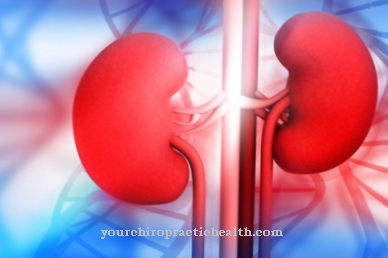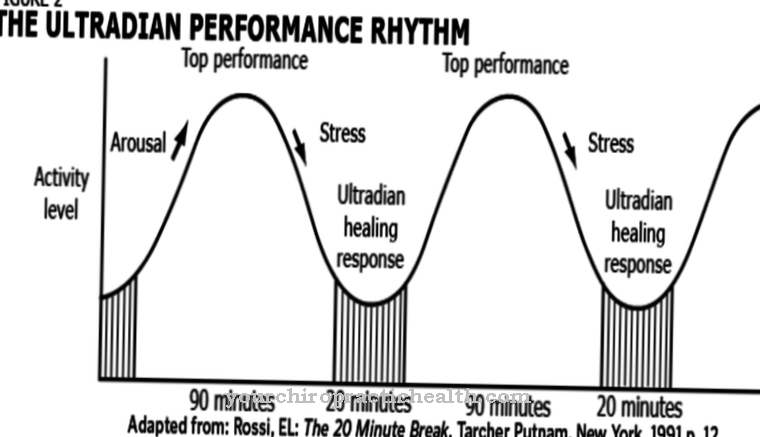The mobility of the joints depends on the level of training and the Extensibility different types of tissue. Sports and everyday exercise activities are significantly influenced by this.
What is the extensibility?

The term elasticity describes the possibilities of a tissue to respond to changes in length with resistance. This ability is very different depending on the tissue composition. Various structures on the musculoskeletal system, the skin and the internal organs are responsible for the ability to stretch and expand. Depending on the function, these can be fascia, ligaments, muscles, tendons, joint capsules or other related types of tissue.
The functionality of the connective tissue components is determined by the composition of the basic substance, which contains certain proportions of fibers and liquid substances. The proportion of these elements is genetically predisposed and determines the viscoelastic properties and thus the elasticity of the tissue. A quantitative shift to the liquid side lowers the resistance to stretching stimuli, while it increases when there are relatively more fibers.
Ribbons, with their relatively high proportion of collagen fibers, are only slightly stretchable in their physiological state. The same applies to the outer layer of the joint capsule. Tendons and fasciae contain comparatively more elastic fibers, which allows a short-term increase in length when stretched, but this is quickly reversed by the retraction forces. The length of a muscle itself can only be changed by contractions within a specified framework. The contractile elements are not elastic and therefore not stretchable.
Function & task
The total elasticity of all types of tissue involved determines the mobility of the joints and the entire body. With movements in everyday life, but especially in sports, the movement amplitude can have a great influence on the quality of movement and strength development. In many sports, for example, the backward movement is an important component for optimal power development at the start and the maximum acceleration distance. The initial strength comes not only from the active contraction of the muscles, but is also fed from the kinetic energy that has arisen from the pre-stretching of the tendons, fasciae and joint capsules. The characteristics of both components is a determining performance factor.
At the same time, the movement becomes more effective as less active force development is necessary. The risk of injury is reduced because the acceleration is not transmitted prematurely to the braking tissue or other joints and body areas. The same principle applies to breathing. When you inhale, the chest and lung tissue are stretched. The resulting retraction force is solely responsible for the return of the thorax during exhalation.
An improvement in elasticity can be achieved through appropriate physical activities, especially in children and adolescents, as the connective tissue still contains a relatively large number of elastic fibers.
In adulthood, training to gain length is much more difficult because the tissue composition has changed. A short-term change in mobility can always be achieved through stretching exercises, but long-term success only through regular and adapted training. The type of stretch and the time of application play an important role in the effectiveness of these measures, especially in sports.
Static stretching, also known as stretching, is still a very popular form of length training in sports, although research in sports science has long shown that dynamic stretches are more effective. Any kind of stretching before sporting activities that require strength, speed or speed is counterproductive. It has a performance-reducing effect, since not so much kinetic energy is achieved through the pre-stretching. A specific warm-up is very important before endurance performance, stretching exercises are not necessary.
The opinion that is often still held that regular stretching reduces the susceptibility to injury to the working muscles has long been scientifically refuted. However, it is important to carefully preheat the muscles through exercises.
Illnesses & ailments
A whole series of diseases is the result of a process that is based on the change in the composition of the tissue and which in some cases considerably restricts the ability to stretch. Either through a reduction in the proportion of liquid in the basic substance or through the increased production of collagen fibers, there is a shift in the quantitative relationships. The collagen fibers move closer together and hydrogen bonds form spontaneously, which make the tissue more interlinked and less elastic. This process is reversible for a certain time, since the bridges can still be loosened, but not later, since fixed disulfide bridges lead to structural contractures of the muscle tissue, sometimes with considerable restrictions on movement.
Such impairments occur in the musculoskeletal system as a result of immobilization in joints or general immobility. Fibroses of various types are also based on this process despite different causes. Pulmonary fibrosis is triggered, for example, by toxins to which the affected people are exposed over a long period of time. The slowly progressive reduction in the ability of the lung tissue to stretch has a considerable negative impact on the respiratory function.
Dupuytren's contracture is a fibromatosis, the cause of which has not yet been clarified. Due to the pathological processes, the connective tissue tendon plate of the palm is hardened and increasingly loses its elasticity. As the disease progresses, the fingers connected to it, especially the ring and little fingers, are drawn to the palm of the hand and become immobile.
Capsule shrinkage that occurs after injuries or surgery can also be explained using the process described. A special form of this disease is the so-called frozen shoulder (frozen shoulder), in which there is massive restriction of movement in the shoulder joint due to the enormously reduced flexibility of the joint capsule. The process is very resistant to any form of therapy.
All injuries associated with tissue destruction are repaired as part of the wound healing process. However, the resulting scar tissue is significantly less elastic than the healthy one. This is not a problem with small scars, but large areas of scarring, such as those caused by burn injuries, can cause considerable mobility deficits.
Physical activity has a major impact on the elasticity of the various tissues. Many paediatricians and sports teachers today complain that children and adolescents are much more immobile than they used to be. That certainly has to do with the changed exercise and leisure behavior. The resulting mobility deficits cannot be eliminated in adulthood or can only be eliminated with great effort.



























